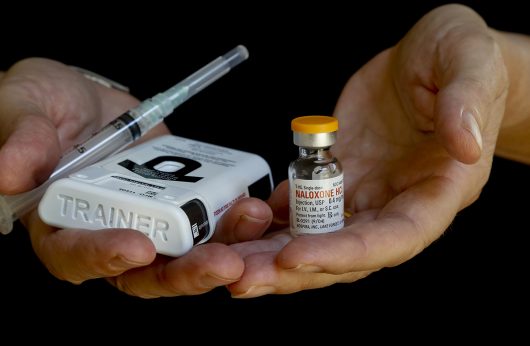
A vial of naloxone and an injector kit of the drug that is used as an antidote to overdoses. Credit: Courtesy of TNS
Ohio State is continuing to increase health services available to students recovering from drug abuse in response to the nation’s heroin epidemic increasingly posing a threat to college-aged students.
Dr. Brad Lander, clinical director of addiction psychiatry at the Wexner Medical Center said the age for those addicted to heroin has dropped significantly.
“The average age of our heroin addicts in our detox unit is about 21. We’re seeing 18-to-24-year-olds, a lot of them, in the detox,” Lander said. “When you saw a heroin addict in years gone by, they were in their 50s.”
Family, friends and drug users alike will now have access to naloxone, used to treat someone who has overdosed before medical help can arrive, at the Wilce Student Health Center on campus.
“(You) do not need to be afraid to go ahead and use it,” said Dr. Kathryn McKee, primary health care physician at the Wilce Student Health Center. “It’s not going to hurt someone.”
“We want to consider (drug addiction) another medical problem.You would not for a moment withhold medical treatment.” —Dr. Kathryn McKee, primary health care physician at the Wilce Student Health Center
University police will be carrying naloxone and have received mandatory training on how to administer the treatment. Additionally, the student health center will be holding an open meeting on Thursday about how to use naloxone and the importance of not being afraid to save another’s life.
“We want to consider (drug addiction) another medical problem,” McKee said. “You would not for a moment withhold medical treatment.”
McKee is also a member of a program called Suboxone Maintenance and Recovery Treatment, also known as SMART, a group available to students who have received 12 months of treatment. The program allows them to receive their medication on campus, allowing them to continue their recovery while in taking class.
Another service available to students is OSU’s Collegiate Recovery Community, an organization dedicated to providing members with a safe space to play games, paint, talk, put on events and meditate with other students in recovery. The CRC has its own floor of dorms in Lincoln Tower, with 28 beds provided exclusively for members.
“(CRC) goes against the narrative of what we see in (The Columbus Dispatch) about people dying,” said Ahmed Hosni, program coordinator at CRC and former drug addict. “There are people out there who are getting their life together, and thriving and surviving.”
Another means of support can be found in Squirrel Recovery, available on Android devices and set to come to iOS soon.
In August 2015, Lander, Wexner Medical Center counselor Brandi Spaulding and students at OSU created the app for recovering heroin addicts. So far, it has been downloaded about 2,400 times. The app allows users to rate their moods, stress levels and drug urges 24/7, all while informing a group of 10 people they designate as their support circle.
Lander said his favorite part about the app is the emergency button, which, once hit, immediately sends a text or email to everyone in their support group.
The app will have GPS as well, so that people can find the addict when they need immediate help.
“Once you’re addicted it’s a lifelong issue,”Lander said.


